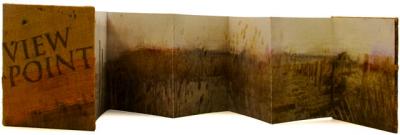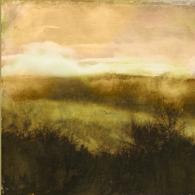The landscapes between photography and painting by Dorothy Simpson Krause
FB: Many of your works look like old prints and they remember me gum bichromate prints, for example some of Keith Gerling works. This ancient style, used surface, presence of scratches, is it a way to retrieve contact with materials, shorten the distance inserted by informatics and technology? Or rather an aesthetic choice to work on memory, thoughts, dreams?
DSK: Keith’s images are haunting, but I would find the process of gum bichromate tedious and repetitive. I’m easily bored and if I’ve done something once, I’m looking for ways to take it to a new level. However, reinventing the wheel for every exhibition can be a bit too challenging when things don’t work as expected.
FB: You often produce hand crafted books of your works. It is a topic that interests me particularly, because a I follow a course of ancient binding techniques. What does a hand made book means to you? How is it different than a picture hanging on a wall?
DSK: My involvement with books began with travel journals, visual records of experiences. I wrote, collaged and drew into them - it was especially nice working for a few weeks with a medium that didn’t crash or require trouble-shooting. When I returned to my studio, I scanned the book pages into the computer and combined them with photographs taken on the trip.
Later, books evolved into places to experiment with concepts, make political statements and take work that wasn’t successful to another level. They have an intimacy, pacing and time-based quality that wall-hanging work lacks. The small format is also appealing since some of my large work is very heavy and requires two people to lift.
FB: I noticed that in the past you worked a lot with collage, photomontage, images that are clearly composite and issues from your mind. Over the last years instead you are producing pictures that have a more direct photographic look. Of course, you still use mixed materials, the overlap of hand painting, you print on unusual surfaces, and so on, but undeniably your images resemble more to those obtained with certain printing techniques that have a pictorial look, but are still straight photographic. What does this evolution in your work mean? Were you concerned in the past with a more symbolist approach, while today you are more interested in a impressionist representation of reality?
DSK: My work seems to be cyclical. I find myself referencing past ways of working as I evolve. The work you call “straight photographic” has only a passing resemblance to the photograph on which it is based and almost all of the series digitally combines photographs and paintings in the final pieces. The output devices and substrates are also varied.
To read the rest of this article go to page: 1 2 3 4 5







Camera Obscura » Vernici per stampe a getto di inchiostro su carta artistica
said, July 26, 2008 @ 9:11 PM :
[...] per esempio Inkaid, una specie di vernice di cui mi ha parlato Dorothy Simpson Krause nella sua intervista e che, almeno così promettono i costruttori, permette di stampare su ogni [...]